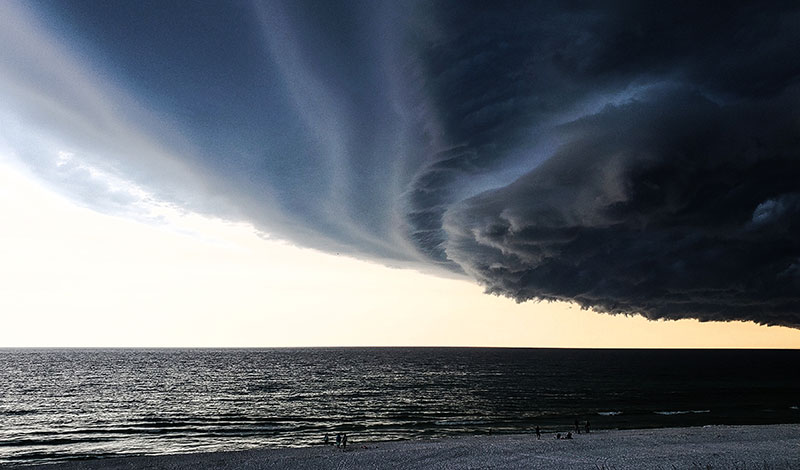Many people might think that since hurricanes form over large bodies of water, such as the Atlantic Ocean and the Gulf of Mexico, they only threaten coastal cities. However, this is a false and dangerous assumption.
Hurricanes can travel several hundred miles inland and cause some terrible damage. One of these interior cities is San Antonio. It is located roughly 140 miles inland from the Gulf of Mexico, so any hurricane that makes a landfall in Texas is typically weakened significantly by the time it reaches Alamo City.
However, while San Antonio has never been struck directly by a hurricane, the city does experience hurricane-related effects. Some of the impacts of hurricanes in the city and other interior regions of the country include winds over 155 miles per hour, flying debris, tornadoes, microbursts, heavy rainfall, landslides or mud slides, and floods.
It bears repeating that holding the assumption of distance from the coast being equivalent to safety from hurricanes can prove to be costly—sometimes fatally so. That is why inland hurricane preparedness is an important, albeit overlooked, aspect of disaster planning. Because one thing is clear: San Antonio’s hurricane risk is real, measurable, and requires serious preparation. Here’s what every resident should know.
Common Hurricane-Related Effects in San Antonio
Because of Alamo City’s location inland, it doesn’t get hit directly by hurricanes. However, as these hurricanes traverse the Texan landscape, they eventually lose steam. The resulting tropical storms, though weaker than hurricanes, can still cause significant flooding and tornadoes.
Tornadoes
A common effect of hurricanes on San Antonio are tornadoes. They typically appear once a hurricane has made landfall.
While the number of tornadoes that hurricanes might produce are not uniform, that is to say, some hurricanes produce several while others none, it is not uncommon. One study observed the development of tornadoes in over 80% of hurricanes that made landfall in the Gulf Coast.
These tornadoes, however, are relatively weak (falling within the lower end of the Enhanced Fujita Scale, i.e., EF0 and EF1) and short lived, in general. Still, their impact can be significant, especially their potential for causing substantial and costly damage. A study estimates that around 3% of tropical storm-related deaths in the country were the result of the tornadoes they spawned.
The creation of tornadoes requires only two main ingredients: instability and wind shear. Heat and humidity in the atmosphere creates instability, while wind shear is the differences in wind speed and direction at different altitudes.
“When a hurricane makes landfall, the winds near the ground slow down, while the upper-level winds keep their momentum,” explained Jonathan Martin and Steve Ackerman (retired), professors at the University of Wisconsin, on The Weather Guys blog. “This can lead to a column of air rotating that can generate a weak tornado.”
Flooding
Flooding might result as an effect of a hurricane that’s miles away from San Antonio. This is exactly what happened in September1921 when moisture associated with a Category 1 hurricane down south of Tampico, Mexico resulted in more than 7 inches of rain in a span of two days.
Dubbed San Antonio’s Great Flood, it is one of the worst natural disasters and among the city’s most destructive floods ever. The Olmos Creek watershed received double the amount of rainfall, and the community of Thrall was inundated with 40 inches of rain in more than three days. There were also reports of floodwaters reaching almost 7 feet in stores, hotels, and theaters.
The Great Flood of 1921 took 51 lives in the city alone. Damages were estimated to total around $19 million or $330 million in today’s money.
Worst Hurricanes That Hit San Antonio
Other than the Great Flood in 1921, San Antonio has had experience with some worse hurricanes, unfortunately. Here are some of them.
Costliest Tornado
In September 1988, Hurricane Gilbert made landfall in the northern part of Mexico. The Category 3 storm did not result in massive flooding in San Antonio. However, what it lacked in flooding, it made up for in tornadoes.
A total of 40 tornadoes hit Texas. Three tornadoes ravaged Bexar County, and 12 others hit the rest of South and Central Texas on September 17, 1988. Some of the areas that were significantly struck by the tornado outbreak were Kelly Field (formerly Kelly Air Force Base), with damages amounting to $28 million, Audie Murphy Hospital, and the Texas Medical Complex, where over 300 homes were ruined or destroyed. The tornadoes racked up an accumulated damage of more than $50 million.
1919 Hurricane
This hurricane is infamous for creating the highest storm surge in Corpus Christi at 16 feet. It made landfall on September 14 and proceeded to cause over $370 million in damages (amount accounts for inflation) and hundreds of people dead.
In Alamo City, there was heavy rainfall that led to flooding along the Nueces, Colorado, Guadalupe, and Brazos rivers. The hurricane also wrecked a railroad.
Hurricane Beulah
A powerful Category 5 hurricane arose from the Gulf of Mexico on September 19, 1967. It made landfall near Brownsville as a Category 3 hurricane the following day. Known as Hurricane Beulah, it is notorious for having spawned 115 tornadoes in the state, although only one tornado hit Bexar County.
In San Antonio, over 5 inches of rain fell, which led to major flooding across the city. However, some areas received more than 30 inches of rain, according to reports. At Goliad, the San Antonio River rose above its flood stage at 18.4 feet.
The situation got so bad in South Texas that then-President Lyndon B. Johnson declared 24 counties as disaster areas. Evacuees numbered 300,000, the sick or injured totaled 9,000, and there were 18 people dead.
Hurricane Madeline
In October 1998, a Category 1 hurricane was observed off the west coast of Mexico. While the hurricane did not make landfall, it contributed to a major flooding in Texas.
Moisture from Hurricane Madeline moved into South Texas, where it interacted with a stalled cold front. This resulted in over 15 inches of rain pouring down on San Antonio; 11.26 inches of that fell in one single day. Heavy rain inevitably caused a flooding event that was one of the worst in the city.





